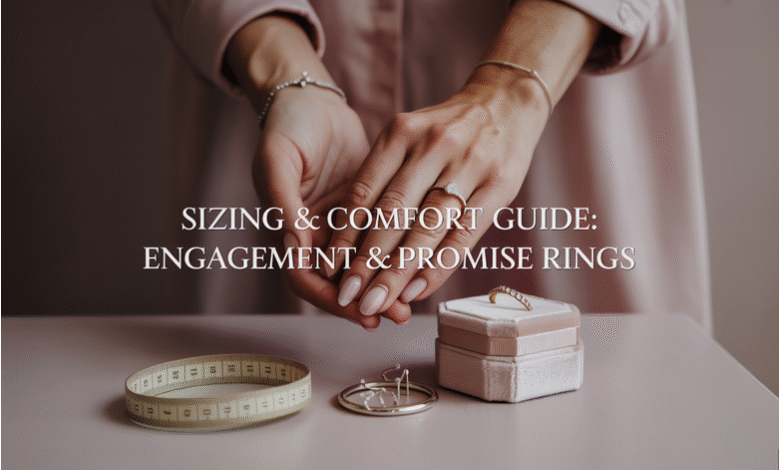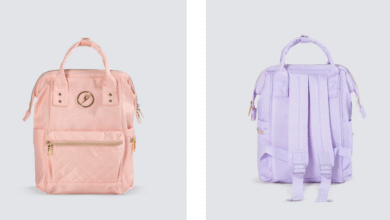Sizing & Comfort Guide: Engagement and Promise Rings

How ring size really works (and why comfort matters)
A ring size is just the inner circumference/diameter—but two rings with the same number can feel different. Why? Band width and thickness. Wider or thicker shanks displace more skin, so they feel tighter. Your size also changes through the day: heat, cold, salty food, workouts, travel, hydration—all impact swelling. Take comfort seriously; a ring you’re proud of should also be one you forget you’re wearing. Size for the largest point (knuckle) while aiming for a secure fit at the base. And remember: half and quarter sizes exist—use them.
Measuring accurately (DIY vs jeweler)
Best case: visit a jeweler for measurements with a mandrel and calibrated sizers, taken more than once. If you’re measuring at home, use a plastic multisizer or compare a known-fit ring against a ruler or sizing chart. Skip string or paper—they stretch and throw results off. When using printable charts, turn off printer scaling and verify with a coin. Take readings morning and evening with warm hands and normal hydration. Good data beats guessing—especially for an engagement ring size guide where precision matters.
Engagement ring sizing essentials (security for center stones)
Engagement rings often carry more “top” (solitaire, halo, three-stone). That extra weight wants to spin, so go for snug-but-comfortable. Band width matters: wider shanks can require +¼–½ size over your skinny-band size. Understand comfort-fit vs standard: a comfort-fit’s rounded interior slides over the knuckle easily and feels looser at rest. If spin persists, ask for euro-shank corners, sizing beads, inner liners, or spring inserts. For active hands, choose low-profile settings and rounded edges to reduce snagging and finger fatigue.
Promise ring sizing essentials (flexible wear, stacking later)
Promise rings skew petite and low-profile, so most wearers are true-to-size—though ultra-slim bands may feel better +¼ size. Finger choice is flexible; many pick the right-hand ring finger to avoid confusion with an engagement ring. Thinking ahead? Choose widths and contours that will stack with future wedding and anniversary bands. If it’s a surprise gift, borrow a ring from the correct hand/finger, use a multisizer, or discreetly ask a friend for her promise ring size.
Fit features that change comfort (beyond the number)
Profile shapes drive feel. Comfort-fit, standard, D-shape, euro-shank—each sits differently on the finger. Thickness and edge treatment matter too: thinner walls and softly chamfered edges reduce pressure. Watch weight balance: top-heavy rings spin; tame them with tapered shanks or interior aids. Metal feel plays a role—platinum and heavier gold feel substantial; sterling is lighter. None is “better,” but perception affects comfort, especially on long days at a keyboard or in gloves.
Resizing rules & limitations (save headaches later)
Resizing is easy on plain bands, most solitaires, and pavé that leaves metal gaps (±1–2 sizes is common). It’s tricky on full/near-full eternity, tension, and channel-set all around—confirm your jeweler’s policy before buying. Some alternative metals (tungsten, titanium) are non-resizable; if you choose them, ask about exchange programs. White gold may need rhodium replating after resizing. If you’ve engraved already, plan on re-engraving post-resize. Smart play: build a 60–90 day resize window into the purchase.
Care, comfort & daily habits
Comfort isn’t just size—it’s how you wear the ring. Remove it for heavy lifting, hot yoga, swimming, or icy water (extreme temps change fit and security). Lotion and soap build up under the ring and make it feel sticky—quick cleanings restore glide. Check fit seasonally; summer hands run bigger than winter. Schedule prong checks to prevent snags on sweaters or hair and to keep stones secure—peace of mind is part of comfort.
Customization & engraving notes (comfort-aware)
A comfort-fit interior slightly reduces engraving space, so keep text short and legible. Choose clean fonts and consider black enamel/oxidized infill for contrast on yellow or rose gold. For daily comfort, ask for rounded edges, micro-texture (satin/brushed) to reduce drag, and avoid overly sharp cathedral shoulders if you’re active. Planning a future reset or stack? Choose a compatible width/contour now so your engagement or promise ring plays nicely with the next pieces.
Quick compare—Engagement vs Promise sizing & comfort
Occasion & build. Engagement rings often carry heavier tops—plan for anti-spin features and a secure base fit. Promise rings are slim, low-profile, and built for all-day ease.
Resizing. Engagement designs are often resizable; promise rings in alternative metals may not be.
Stacking. Engagement rings must match the wedding band; promise rings should be stack-friendly or reset-ready down the road.
Buyer checklist + FAQs
Checklist: Verify size with 2–3 readings → choose band width & profile → decide comfort-fit vs standard → match setting height to lifestyle → plan anti-spin if top-heavy → confirm resizing policy and metal limits → lock engraving after final size → schedule maintenance.
How tight should a ring be?
It should slide on with mild resistance, twist over the knuckle, and rest securely without deep marks. If you need soap to remove it at room temp, it’s probably too tight.
Can I fix spinning without resizing?
Yes. Try sizing beads, an inner silicone guard, spring inserts, or a euro-shank redesign. Your jeweler can test options while you wait.
Different size for wider bands?
Often yes—go +¼ to +½ size versus your slim-band size, then fine-tune in person. Comfort is personal; trust the feel, not just the number.


